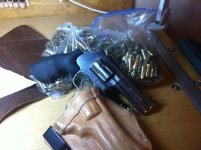Recoil is primarily a factor of weight but I don't think you'll be able to tell much difference here. Smith Wesson lists their modern six inch N-frame at 45 ounces and the six inch L-frame at 46.3 ounces, yet the frame on the N-frames are slightly bigger and heavier. The L-frame gains weight because it has a full length barrel underlug (runs the entire length of the barrel) and the N-frame does not. The underlug shrouds the revolver's ejection rod. This effects the balance of the handgun and that is a matter of personal choice. I prefer the shorter underlug.
As others have mentioned, the L-frame has a smaller grip frame which a lot of shooters prefer. I do not like the Model 27 target stocks because of the size. You can replace these with a nice, smaller set or do what I did and get some fairly inexpensive "rubbers" from Hogue or Pachmayer. With your sensitivity to recoil, I would suggest those over traditional hardwood grips.
With soft .38 specials, both of these guns should recoil considerably less than the 9mm from your Beretta.Sellier and Bellot make some 148 gr. wadcutters that are positively mild.
As others have mentioned, the L-frame has a smaller grip frame which a lot of shooters prefer. I do not like the Model 27 target stocks because of the size. You can replace these with a nice, smaller set or do what I did and get some fairly inexpensive "rubbers" from Hogue or Pachmayer. With your sensitivity to recoil, I would suggest those over traditional hardwood grips.
With soft .38 specials, both of these guns should recoil considerably less than the 9mm from your Beretta.Sellier and Bellot make some 148 gr. wadcutters that are positively mild.





